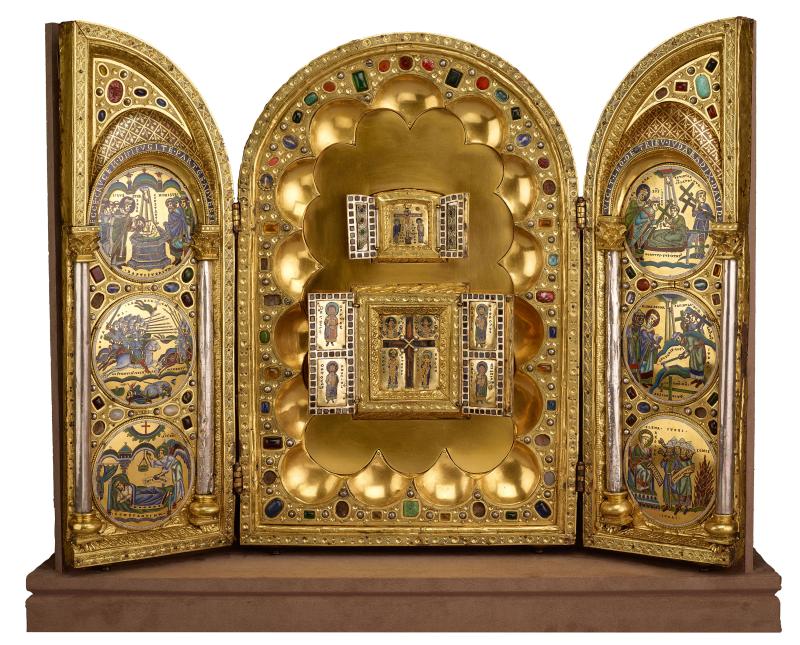
This glorious, jewel-studded triptych-a work of art in three sections-was likely commissioned in the 1150s by Wibald (1098-1158), Abbot of the Benedictine monastery of Stavelot (in present-day Belgium), as a reliquary to hold fragments of the True Cross, as well as relics from the Church of the Holy Sepulchre and remnants from the Virgin's dress. In the reliquary's central section are mounted two small Byzantine triptychs, dating from the late eleventh or early twelfth century, which Wibald probably acquired on one of his diplomatic missions to Constantinople. The most sacred of Christian relics is encased in the center of the lower triptych, decorated with two gold pins and four tiny pearls. Its two wings are adorned with figures of four Byzantine military saints, considered holy warriors. These flank the Archangels Gabriel and Michael in glory above Emperor Constantine (ca. 273-337) and his mother Helena (ca. 250-329), portrayed standing at either side of the Cross. The smaller triptych above shows Christ on the Cross attended by the Virgin Mary at left and Saint John the Evangelist at right.
The larger wings are decorated with six roundels, made by artists from the Meuse region in the ancient diocese of Liège, relating episodes in the life of Constantine and Helena. They are among the finest and best preserved twelfth-century enamels produced in a technique known as champlevé, in which the vitreous enamel is contained in cavities hollowed out of a thick copper plate. Reading from bottom left, we see the sleeping Emperor Constantine to whom an angel appears in a dream telling him to go into battle under the sign of the True Cross (“By This, Conquer.”). Above, Constantine and his army are shown defeating Emperor Maxentius in battle at the Milvian Bridge in 312 AD. At upper left Constantine is baptized by Pope Silvester. The roundels on the right-hand panel are devoted to Helena's discovery of the True Cross in Jerusalem. Again, starting at the bottom, we see her interrogating by fire a group of Jews who inform her that a certain Judas knows the location of the Cross. In the roundel above, the aforementioned Judas is shown excavating the three crosses at Golgotha. At upper right, a bishop (Makarios?)-shown next to Saint Helena, crowned by a double tiara-identifies the True Cross when it miraculously restores the seated young man to life. The Abbot of Stavelot served as an adviser and agent for three successive Holy Roman Emperors and was a fervent supporter of the Second Crusade. Evoking the majesty of the Heavenly Jerusalem, the Stavelot Triptych also championed the cause of maintaining Christian control of the earthly city itself.
The Abbot of Stavelot served as an adviser and agent for three successive Holy Roman Emperors and was a fervent supporter of the Second Crusade. Evoking the majesty of the Heavenly Jerusalem, the Stavelot Triptych also championed the cause of maintaining Christian control of the earthly city itself.
Central panel - contains two Byzantine triptychs. The upper triptych depicts the Annunciation and the Crucifixion. The lower triptych depicts the four Evangelists, four Byzantine military saints, and Constantine and Helena flanking the relics of the True Cross. Wings - contain six enamel medallions (three in each wing) telling the legend of the True Cross.
The upper Byzantine triptych depicts the Annunciation (outer wings) and Mary and John beside the Crucifixion (center panel). The lower Byzantine triptych depicts the four Evangelists (outer wings), four Byzantine military saints (inner wings): George and Procopius on the left, Theodore and Demetrius on the right. In the center, beneath busts of the Archangels Gabriel and Michael, and flanking the True Cross composed of the relic itself, are Emperor Constantine and his mother, Empress Helena. The wings contain six enamel medallions (three in each wing) telling the legend of the True Cross.
